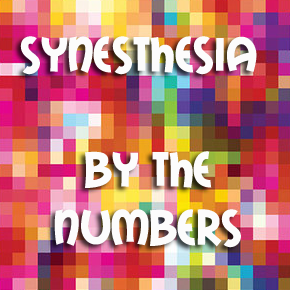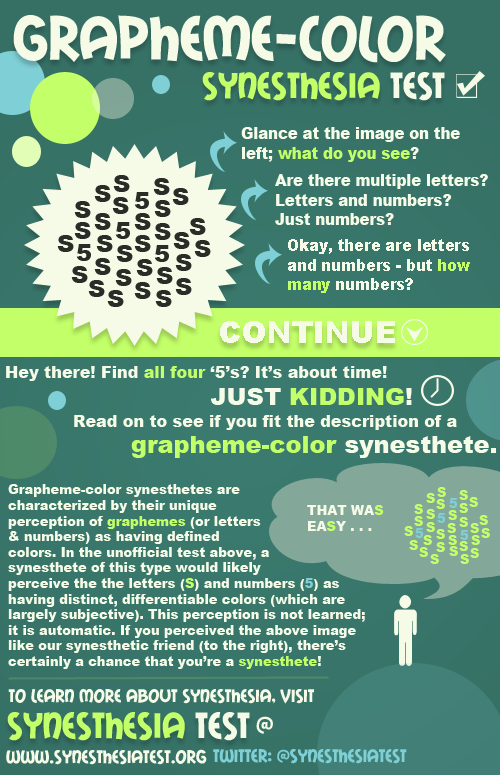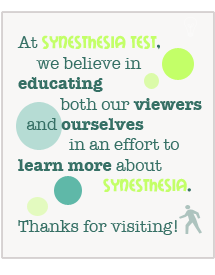Synesthetic Experiences – Involuntary & Consistent?
 Curious as to whether or not you have synesthesia? Looking for a synesthesia test to validate your suspicions or put them to rest? That’s all well and good. While our test is still in development, there are a few litmus tests (or questions, rather) that you can ask yourself before moving forward. The first of which is: Are my synesthetic experiences involuntary and consistent? Now, I realize that this question is quite ambiguous (in that it can be interpreted in a few different ways), so we’ll use the rest of this blog post to define each of these terms and clear up any misconceptions. Let’s get to it!
Curious as to whether or not you have synesthesia? Looking for a synesthesia test to validate your suspicions or put them to rest? That’s all well and good. While our test is still in development, there are a few litmus tests (or questions, rather) that you can ask yourself before moving forward. The first of which is: Are my synesthetic experiences involuntary and consistent? Now, I realize that this question is quite ambiguous (in that it can be interpreted in a few different ways), so we’ll use the rest of this blog post to define each of these terms and clear up any misconceptions. Let’s get to it!
Defining ‘Involuntary’
As there are two definitive elements to this question, we’ll address each individually. First up is the term ‘involuntary’. If experiences are involuntary, they aren’t a result of will, purposeful association, or mnemonic aptitude. In other words, you aren’t “trying” to experience or perceive something a certain way. Also, the experience usually isn’t one that’s naturally intuitive. For instance, if you associate the number ‘2’ with the letter ‘B’, it likely isn’t indicative of synesthesia. ‘B’ is the second letter in the alphabet; it only makes sense.
If, however, your experiences are triggered involuntarily (or by some external factor – separate from your own will), you may pass GO, collect $200, and spend it as you please. Maybe buy a loved one something nice for Valentine’s day – I don’t know; just an idea.
Defining ‘Consistent’
The consistency of your experiences can also be very telling. Neurologist and renowned synesthesia researcher, Richard Cytowic lists the following as one of the main criteria for identifying synesthesia: “Synesthetic percepts are consistent and generic.” The example that I use (probably too frequently) is the case of a true grapheme-color synesthete – for whom each letter in the alphabet triggers a given color in his or her mind’s eye. Now, each time the letter is physically seen, the synesthete perceives it as having one color – a color that is consistently and involuntarily associated with the particular letter. If the letter ‘A’ is red, it is always red. If ‘Z’ is yellow, it is always yellow. That’s consistency.
Since I’ve opened the ‘generic’ can, I’ll explain that, as well. The term ‘generic’ refers to percepts that are simple, rather than extravagant. For instance, when a given synesthete hears a certain tone, he or she might picture a black square in space. For another tone, perhaps an orange square is visualized. Notice the pattern? The shapes are simple, or generic – not grand visualizations of colors dancing around in harmony. While this concept has been disputed (and there are always exceptions), it’s certainly worth considering.
Moving Forward
Now that I’ve explained the question (or disambiguated it, if you will), ask yourself again: Are my synesthetic experiences involuntary and consistent? If not, well, you’re with the other 198 of us out of a 200 person sample size. If so, you might want to seek out more information about the condition. Either way, this is a great place to start.
If you enjoyed this post, please stop back! We’re in the process of developing an interactive test for synesthesia and would love it if you were around for its release! Follow us on Twitter for updates @SynesthesiaTest. Farewell, friends.
 Hey there, folks! How’s it going? Good? Good. Let’s begin by addressing the question posed in the title of this post. If you’re not familiar with The Bouba-Kiki Effect, bear with me. We’ll start with a basic explanation and move forward with some of the deeper implications. If you’ve ever searched for ‘synesthesia test’, ‘test for synesthesia’, or something similar, chances are that you’ve come across the Bouba-Kiki image (shown lower in this post): two distinct shapes – one Bouba, and one Kiki. Which is which, though? (Scroll down, look at the image, and decide for yourself.) Actually, there’s no correct answer. This image (coupled with the question of which is Kiki, and which is Bouba) is not so much a test for synesthesia as it is evidence of the fact that shapes are not necessarily named arbitrarily – an experiment first conducted in 1929 by
Hey there, folks! How’s it going? Good? Good. Let’s begin by addressing the question posed in the title of this post. If you’re not familiar with The Bouba-Kiki Effect, bear with me. We’ll start with a basic explanation and move forward with some of the deeper implications. If you’ve ever searched for ‘synesthesia test’, ‘test for synesthesia’, or something similar, chances are that you’ve come across the Bouba-Kiki image (shown lower in this post): two distinct shapes – one Bouba, and one Kiki. Which is which, though? (Scroll down, look at the image, and decide for yourself.) Actually, there’s no correct answer. This image (coupled with the question of which is Kiki, and which is Bouba) is not so much a test for synesthesia as it is evidence of the fact that shapes are not necessarily named arbitrarily – an experiment first conducted in 1929 by 

 Hey there, ladies and gents! Welcome back! How’d that last synesthesia test go? This post will focus predominantly on synesthesia statistics, or the stats, percentages, and general facts that quantify the neurological condition. Let’s get goin’! First off, women and those who are predominantly left-handed make up the majority of the synethete population in the world. The female-to-male ratio is 3:1 (75%) in terms of the amount of synesthetes in the world. The condition itself is considered “rare” since only 1 in every 2000 people in the world have synesthesia. Another factor to consider is that considering that this condition is
Hey there, ladies and gents! Welcome back! How’d that last synesthesia test go? This post will focus predominantly on synesthesia statistics, or the stats, percentages, and general facts that quantify the neurological condition. Let’s get goin’! First off, women and those who are predominantly left-handed make up the majority of the synethete population in the world. The female-to-male ratio is 3:1 (75%) in terms of the amount of synesthetes in the world. The condition itself is considered “rare” since only 1 in every 2000 people in the world have synesthesia. Another factor to consider is that considering that this condition is 




